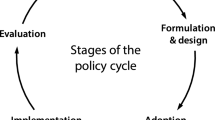Abstract
According to recent surveys, transparency has become a key issue in business decisions. Foreign firms increasingly view transparent economic policies as crucial in their investment planning. Evidence has shown that clear and predictable environments play an important role in companies’ decisions to develop their activities in a specific place. Nowadays, place branding scholars and practitioners alike call for more transparency and responsibility in branding strategies, assuming that trust, enhanced by transparency, is needed to improve the attractiveness of a place. In a study by a major consulting firm, investors in Switzerland specifically mentioned stability and transparency as the most important location factors. However, the country scores poorly in terms of financial transparency. This paradox reveals a degree of confusion about the nature of transparency, which is addressed in this article. We argue that, while transparency of the regulatory framework can effectively improve the attractiveness of a place, opacity of legal requirements may also attract foreign investors. In this sense, transparency of and required by the rules can be at odds. A nuanced approach to transparency and a more detailed analysis are needed to provide a clearer explanation of the relationship between transparency and the attractiveness of a place.
Similar content being viewed by others
References
Alaux, C., Serval, S. and Zeller C. (2015) Marketing territorial des petits et moyens territoires: Identité, image et relations. Gestion et Management Public 4: 61–78.
Anholt, S. (2009) Places: Identity, Image And Reputation. Basingstoke and New York: Palgrave Macmillan.
Anholt, S. and van Gelder, S. (2003) Branding for good? In: N. Ind (ed.) Beyond Branding: How the New Values of Transparency and Integrity are Changing the World of Brands. London, UK: Kogan Page Publishers, pp. 56–68.
Anttiroiko, A-V. (2014) The Political Economy of City Branding. London: Routledge.
Babey, N. and Giauque D. (2009) Management Urbain: Essai sur le Mimétisme et la Différenciation. Quebec: Presses de l’Université Laval.
Balderjahn, I. (2014) Standortmarketing. Munich: UVK Lucius UTB.
Baume, S. and Papadopoulos, Y. (2012) Bentham revisited: Transparency as a “Magic” concept, its justifications and its skeptics. In: Proceedings of the Transatlantic Conference on Transparency Research, June 7. Utrecht, The Netherlands: University of Utrecht.
Best, J. (2005) The Limits of Transparency: Ambiguity and the History of International Finance. Ithaca, NY, USA: Cornell University Press.
Bevan, A.A. and Estrin, S. (2004) The determinants of foreign direct investment into European transition economies. Journal of Comparative Economics 32(4): 775–787.
Bianchini, F. and Ghilardi, L. (2007) Thinking culturally about place. Place Branding and Public Diplomacy 3(4): 280–286.
Birnleitner, H. (2014) Attractiveness of countries for foreign direct investments from the macro-economic perspective. In: Proceedings of the fikusz’14, 14 november. Budapest, Hungary: Obuda University.
Bosley, C. and Kolesnikova, M. (2013) Swiss Reject Tougher Regulation of Commodities Trading. Bloomberg, 27 March, (online), retrieved, http://www.bloomberg.com/news/articles/2013-03-27/swiss-reject-tougher-regulation-of-commodities-trading, accessed 14 January 2016.
Braun, E. (2008) City Marketing: Towards an Integrated Approach. Rotterdam: Erasmus Research Institute of Management (ERIM).
Broulis, P. (2016) Conference on Tax Reforms in the Canton of Vaud. University of Lausanne, Bâtiment l’IDHEAP, Lausanne, Switzerland, 29 February.
Carpenter, M.A. and Dunung, SP. (2011) International Business: Opportunities and Challenges in a Flattening World. Washington, D.C.: Flat World Knowledge.
Chiomento, B., Robinson, P. and Miolo, A. (2014) Setting Standards: Switzerland as a Business Location 2014. EY’s attractiveness survey, (online), retrieved, http://www.sccc.ch/download/publications/2014/20140610_EY_Swiss-attractiveness-survey-en.pdf, accessed 13 December 2015.
Drabek, Z. and Payne, W. (2002) The impact of transparency on foreign direct investment. Journal of Economic Integration 17(4): 777–810.
Elliott, R.K. and Jacobson, P.D. (1994) Costs and benefits of business information disclosure. Accounting Horizons 8(4): 80–96.
Eshuis, J., Klijn, E.-H. and Braun, E. (2014) Place marketing and citizen participation: Branding as strategy to address the emotional dimension of policy making? International Review of Administrative Sciences 80(1): 151–171.
European Commission. (2015) European Innovation Scorecard 2015. Report prepared for the directorate-general – internal market, industry, entrepreneurship and SMEs, (online), retrieved, http://ec.europa.eu/growth/industry/innovation/facts-figures/scoreboards/index_en.htm, accessed 26 March 2016.
Federal Council. (2013) Background Report: Commodities, Report of the Interdepartemental Plattform on Commodities to the Federal Council, (online), retrieved, https://www.admin.ch/gov/en/start/dokumentation/medienmitteilungen.msg-id-48319.html.
Feige, S., Fischer, PM., von Matt, D. et al (2014) Swissness ou l’identité suisse pour les PME: image de la Suisse et valeur ajoutée dans le marketing international. PostFinance Report, (online), retrieved, https://www.postfinance.ch/binp/postfinance/public/dam.6zU3bq0YXCOlpFytRN0vHT638iqiJZ8pqcYzihvjXgU.spool/content/dam/izv/doc/swissness_fr.pdf, accessed 7 November 2015.
Florini, A. (2000) Does the Invisible Hand Need a Transparent Glove? The Politics of Transparency. Washington, D.C.: World Bank Annual Conference on Development Economics: 163–184.
Franklin, J. (2014) Swiss Charge ex-HSBC Staffer with Industrial Espionage. Reuters, 11 December, (online), retrieved, http://uk.reuters.com/article/uk-swiss-hsbc-idUKKBN0JP18020141211, accessed 6 January 2016.
FutureBrand. (2015) FutureBrand Launches the Country Brand Index. FutureBrand news, 11 November, (online), retrieved, http://www.futurebrand.com/news/2014/futurebrand-launches-the-country-brand-index-2014-15, accessed 8 January 2016.
Garessus, E. (2016) Le « système immunitaire de la Suisse » s’affaiblit, selon l’historien James Breiding. Le Temps, 16 February, (online), retrieved, https://www.letemps.ch/economie/2016/02/17/systeme-economique-suisse-s-affaiblit-selon-historien-james-breiding, accessed 13 February 2016.
Gelos, R.G. and Wie, S.-J. (2002) Transparency and International Investor Behavior. Cambridge, MA: National Bureau of Economic Research. NBER Working Paper No. 9260.
Gillies, A. (2013) Crafting a strategic response to the commodity-development conundrum. A response to “Commodities and Switzerland: Development Policy Challenges and Policy Options” by Werner Thut. International Development Policy| Revue internationale de politique de développement 4(2): 153–193.
Globerman, S. and Shapiro, D.M. (1999) The impact of government policies on foreign direct investment: The canadian experience. Journal of International Business Studies 30(3): 513–532.
Govers, R. and Go, F. (2009) Place Branding: Glocal, Virtual and Physical Identities, Constructed, Imagined and Experienced. Basingstoke, Hampshire, UK and New York, NY, USA: Palgrave Macmillan.
Grimmelikhuijsen, SG., Porumbescu, G., Hong, B. et al (2013) The effect of transparency on trust in government: A cross‐national comparative experiment. Public Administration Review 73(4): 575–586.
Guo, Y. and Woo, J.J. (2016) Singapore and Switzerland: Secrets to Small State Success. Singapore: World Scientific Publishing Co.
Habib, M. and Zurawicki, L. (2002) Corruption and foreign direct investment. Journal of International Business Studies 33(2): 291–307.
Heald, D. and Hood, C. (eds.) (2006) Transparency: The Key to Better Governance? Oxford: Oxford University Press.
IMD. (2015) 2015 IMD World Competitiveness Scoreboard. IMD World Competitiveness Yearbook, (online), retrieved, http://www.imd.org/uupload/imd.website/wcc/scoreboard.pdf, accessed 18 January 2016.
IMF. (2001) Standards and Codes: The IMF’s Role. IMF Staff report, April, (online), retrieved, https://www.imf.org/external/np/exr/ib/2001/fra/042701f.htm, accessed 21 January 2016.
Ind, N. (ed.) (2003) Beyond Branding. How the New Values Of Transparency and Integrity are Changing the World of Brands. London, UK and Sterling, VA, USA: Kogan Page Publishers.
Jacobsen, B.P. (2012) Place brand equity: A model for establishing the effectiveness of place brands. Journal of Place Management and Development 5(3): 253–271.
Johannesen, N. and Zucman, G. (2014) The end of bank secrecy? An evaluation of the G20 tax haven crackdown. American Economic Journal: Economic Policy 6(1): 65–91.
Kalandides, A. and Kavaratzis, M. (2012) From “necessary evil” to necessity: Stakeholders’ involvement in place branding. Journal of Place Management and Development 5(1): 7–19.
Kapferer, J.-N. (2013) Ré-inventer les marques: La fin des marques telles que nous les connaissons. Paris: Editions Eyrolles.
Kavaratzis, M. (2004) From city marketing to city branding: Towards a theoretical framework for developing city brands. Place Branding 1(1): 58–73.
Kavaratzis, M. (2009) Cities and their brands: Lessons from corporate branding. Place Branding and Public Diplomacy 5(1): 26–37.
Kotler, P. (2002) Marketing Places. New York, NY: Simon and Schuster.
KPMG. (2016) The Home for Business? Assessing the Competitiveness of the UK. KPMG report, March, (online), retrieved, https://assets.kpmg.com/content/dam/kpmg/pdf/2016/03/uk-competitiveness-report-2016.pdf, accessed 26 June 2016.
Laulajainen, R. and Stafford, H.A. (1995) Corporate Geography: Business Location Principles and Cases. Dordrecht, The Netherlands: Kluwer Academic Publishers.
Mabillard, V. and Pasquier, M. (2016) Transparency and trust in government (2007-2014): A comparative study. In: E-Proceedings of the 9th Trans European Dialogue Conference. 4-5 February 2016. Ljubljana, Slovenia: University of Ljubljana.
Mayes, R. (2008) A place in the sun: The politics of place, identity and branding. Place Branding and Public Diplomacy 4(2): 124–135.
Mazars and Marccus Partners. (2009) Transparency Directive Assessment Report for the European Commission Internal Market and Services DG, (online), retrieved, http://ec.europa.eu/finance/securities/docs/transparency/report-application_en.pdf.
Mishrif, A. (2010) Investing in the Middle East: The Political Economy of European Direct Investment in Egypt. London: IB Tauris.
New Zealand Trade and Enterprise. (2016) New Zealand’s Investment Advantage, (online), retrieved, http://www.nzte.govt.nz/en/invest/new-zealands-investment-advantage/#toc-safe-stable-and-secure-business-environment, accessed 24 June 2016.
OECD. (2011) Attractiveness for Innovation: Location Factors for International Investment. Paris: OECD Publishing.
OECD. (2015) Policy Framework for Investment. Paris: OECD Publishing.
Pasquier, M. and Zumofen, R. (2015) Image resilience after multiple crises: The case of Switzerland in the United States. Die Unternehmung 69(2): 182–192.
Pasquier, M., Richard, MW. and Yersin, N. (2009) Das Image der Schweiz im Ausland: mit Fallbeispiel China. Bern: Haupt Verlag.
Pinson, J. (2016) From the Olympic dream to a down to earth approach: Lausanne’s sports events hosting strategy. Sport in Society 19(6): 828–839.
Presence Switzerland. (2014) Switzerland Seen from Outside in 2014: Switzerland’s Image Shaped by Direct Diplomacy and Foreign Policy. Presence Switzerland report, 23 December, (online), retrieved, https://www.eda.admin.ch/dam/eda/en/documents/das-eda/landeskommunikation/jahresanalyse-image-ch-ausland-2014_EN.pdf, accessed 9 November 2015.
Reis, JG. and Farole, T. (2012) Trade Competitiveness Diagnostic Toolkit. Washington, DC: World Bank Publications.
Ruijer, E. and Meijer, A. (2016) National transparency regimes: Rules or principles? A comparative analysis of the United States and the Netherlands. International Journal of Public Administration, advance online publication 28 January 2016. doi: 10.1080/01900692.2015.1057343.
Savoia, R., Hess, J. and Fischli, N. (2013) IP: Switzerland Remains Attractive for IP Exploitation. International Tax Review, 12 March, (online), retrieved, http://www.internationaltaxreview.com/Article/3167162/IP-Switzerland-remains-attractive-for-IP-exploitation.html, accessed 23 February 2016.
Schlaepfer, RC. and Reppas, R. (2013) Trends in International Investment Flows from and to SWITZERLAND. Swiss-American Chamber of Commerce Yearbook 2013, (online), retrieved, https://www.amcham.ch/publications/downloads/2013/yb/trends_in_international_investment_flows.pdf, accessed 12 December 2015.
Schwab, K. (2015) The Global Competitiveness Report 2015–2016. Geneva: World Economic Forum.
SECO. (2015) Economic Governance. State Secretariat for Economic Affairs (SECO) report, (online), retrieved, http://www.seco-cooperation.admin.ch/themen/00911/00912/?lang=fr, accessed 18 January 2016.
Smarzynska, B.K. and Wei, S.-J. (2000) Corruption and Composition of Foreign Direct Investment: Firm-Level Evidence. Cambridge, MA: National Bureau of Economic Research. NBER Working Paper No. 7969.
Snieska, V. and Zykiene I. (2015) City attractiveness for investment: Characteristics and underlying factors. Procedia-Social and Behavioral Sciences 213(1): 48–54.
The Anholt-GfK Roper Nation Brands Index. (2009) The Anholt-GfK Roper Nation Brands Index SM. Report prepared for Switzerland, August, (online), retrieved, https://www.eda.admin.ch/content/dam/eda/de/documents/das-eda/landeskommunikation/Switzerland_2009_NBI_Report_08-31-2009.pdf, accessed 12 March 2015.
The Boston Consulting Group. (2012) Multinational Companies in Geneva and Vaud: Growth Engine at Risk! Joint study with the Swiss-American chamber of commerce, June, (online), retrieved, http://www.amcham.ch/publications/downloads/20120612_bcg_amcham_study_en.pdf, accessed 7 March 2016.
The Good Country Index. (2016) The Good Country Index. Overall rankings, Version 1.1, (online), retrieved, http://www.goodcountry.org/overall, accessed 4 March 2016.
TJN. (2015) Financial Secrecy Index. 2015 Results, http://www.financialsecrecyindex.com/introduction/fsi-2015-results, accessed 17 February 2016.
U.S. Department of State. (2011) Department of State: 2014 Investment Climate Statement. U.S. Department of State report, June, (online), retrieved, http://www.state.gov/documents/organization/227456.pdf, accessed 25 February 2016.
Vuignier, R. (2016) Place Marketing and Place Branding: A systematic (and Tentatively Exhaustive) Literature Review. Lausanne, Switzerland: Swiss Graduate School of Public Administration (IDHEAP). Working Paper 5/2016.
Wrage, A. (2015) Ownership of Privately-Held Companies: Privacy Versus Transparency. Forbes, 18 August, (online), retrieved, http://www.forbes.com/sites/alexandrawrage/2015/08/18/ownership-of-privately-held-companies-privacy-versus-transparency/#3ddf285417bb, accessed 12 March 2016.
Yin, R.K. (2012). Applications of Case Study Research. Thousand Oaks, CA, USA: SAGE Publications.
Zavattaro, S.M. (2014) Place Branding Through Phases of the Image: Balancing Image and Substance. Basingstoke, Hampshire, UK and New York, NY, USA: Palgrave Macmillan.
Zenker, S. and Jacobsen, B.P. (2015) Inter-Regional Place Branding. New York: Springer.
Zhao, J.H., Kim, S,H. and Du, J. (2003) The impact of corruption and transparency on foreign direct investment: An empirical analysis. MIR: Management International Review: 41–62.
Author information
Authors and Affiliations
Corresponding author
Rights and permissions
About this article
Cite this article
Mabillard, V., Vuignier, R. The less transparent, the more attractive? A critical perspective on transparency and place branding. Place Brand Public Dipl 13, 348–359 (2017). https://doi.org/10.1057/s41254-016-0051-5
Revised:
Published:
Issue Date:
DOI: https://doi.org/10.1057/s41254-016-0051-5




